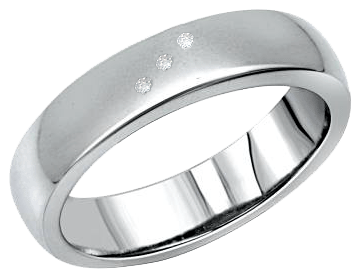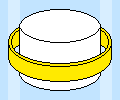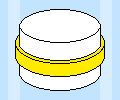
Previous: Metal Clay Shrinkage Calculators
This page has a ring size calculator, to find your ring size from another ring or from measuring your finger. After you know your ring size, you can use another calculator to find the right size to make a ring in metal clay.
Ring size is based either on the inside diameterThe length of a straight line through the center of a circle. or inside circumferenceThe distance around the edge of a circle. of the ring. This may be measured in millimeters or inches.

In some countries, the ring size is the same as the measurement—40mm
circumference is equivalent to a size 40 ring.
In other countries, ring size must be calculated.
For instance, an increase of one ring size may change the ring circumference by 1.25 mm.

Your local jeweler can measure your ring size. Or if you have a ring mandrelAn object used to shape the work. A ring mandrel is usually a tapered cylinder of wood or metal., you can measure one of your rings on the mandrel.
If you would like to determine your ring size, follow these guidelines for measuring your finger:
A finger on your right hand may not be the same size as that finger on your left hand. Your fingers may be larger in the evening. Finger size can also be affected by weather—depending on where you live, your finger measurement may change in different seasons. Fingers tend to be smaller in winter or cool weather.
After you have determined your final ring size, verify that it is correct.
Note: A wide ring will usually need to be sized larger to be comfortable.
If you do not know your ring size, you can use a piece of paper or non-stretch string to measure the distance around your finger (circumference). Or, you can measure the diameter across the inside of a ring that fits your finger. Note that calculations from ring diameter may not be as accurate. This is the final ring size; a metal clay ring will need to be made larger to accommodate shrinkage.
in

It is a good idea to verify your ring size, since you may be very close to another size. Your size also varies depending on the width of the ring. To be comfortable, wide rings usually need to be larger than narrow rings.
To verify your ring size, make a strip from cardstock, thick paper, or a double thickness of regular paper. This strip should be approximately as wide as the completed ring. Use the final ring circumference in millimeters to cut the strip to length. Tape the strip into a circle so the ends meet, with no gap or overlap. If this ring fits easily, the size is correct.
This calculator will find the circumference from the ring size. This circumference can be used to verify your ring size or create your own mandrel. Enter number or letter half-sizes with a decimal, such as “Z + 1.5” or “D.5” for a D 1/2 size ring.
A temporary ring mandrel may be made by tightly winding paper around a cylinder, such as a wooden dowel. Use non-stick paper, such as freezer paper with the shiny side out, as the outside layer. Pull out the middle of the paper roll to remove the ring.
If you are using a mandrel, wrap a strip of nonstick paper around the mandrel before making the ring.
Note: If you have an aluminum ring mandrel, don't let it come into direct contact with the metal clay.
Note: The metal clay ring should be gently removed from the mandrel, or moved to a smaller size on the mandrel, before it dries completely. The ring will shrink a little as it dries.
Metal clay shrinks when it is fired and the binder burns away. Because of this, a metal clay ring must be made larger than the desired ring size.
Keep in mind that metal clay is not as strong as the regular metal. In addition, silver jewelry is usually made from alloys that are stronger than pure metal. Metal clay rings may receive a lot of wear, so need to be thick enough to avoid bending or breaking.
Metal clay for normal thin rings is rolled out to 4-6 cards (about 1 mm). Wide rings may be thicker, up to 2 mm. Most metal clay rings are usually between 1 mm and 2 mm in thickness.
This calculator will find the ring size to make in metal clay, based on the final ring size. When the ring is fired, it should shrink to the correct size. Remember that firing longer and hotter will cause more shrinkage. If you plan to sand the inside of the ring thoroughly before firing, you may need to make the metal clay ring a little smaller. Sanding the inside can change the ring by more than 1/2 size (United States).
Note: This calculator is based on straight percentage shrinkage. These sizes are slightly larger than typical recommendations. Some experimentation may be required to find the exact size.


In the United States, many recommend making the metal clay ring 11/2 to 3 sizes larger than your ring size, for clay with a low shrinkage rate.
The ring may be placed on a ring pellet (or ring plug) for firing. The ring pellet is the same size as the finished ring—the metal clay ring will shrink around the pellet when it is fired. The pellet does not allow the ring to shrink smaller than that size. If the ring pellet is too large for the metal clay ring, the ring will get thinner when it shrinks around the pellet and may break. The ring pellet will also keep the ring round if it includes a heavy stone.
Pellet molds can be purchased from many suppliers—investment is poured into the mold to make the pellet. You can also use a freezer paper ring and investment plaster or paper clay to create your own pellet. Make sure any homemade ring pellet is round instead of oval, and as smooth as possible.